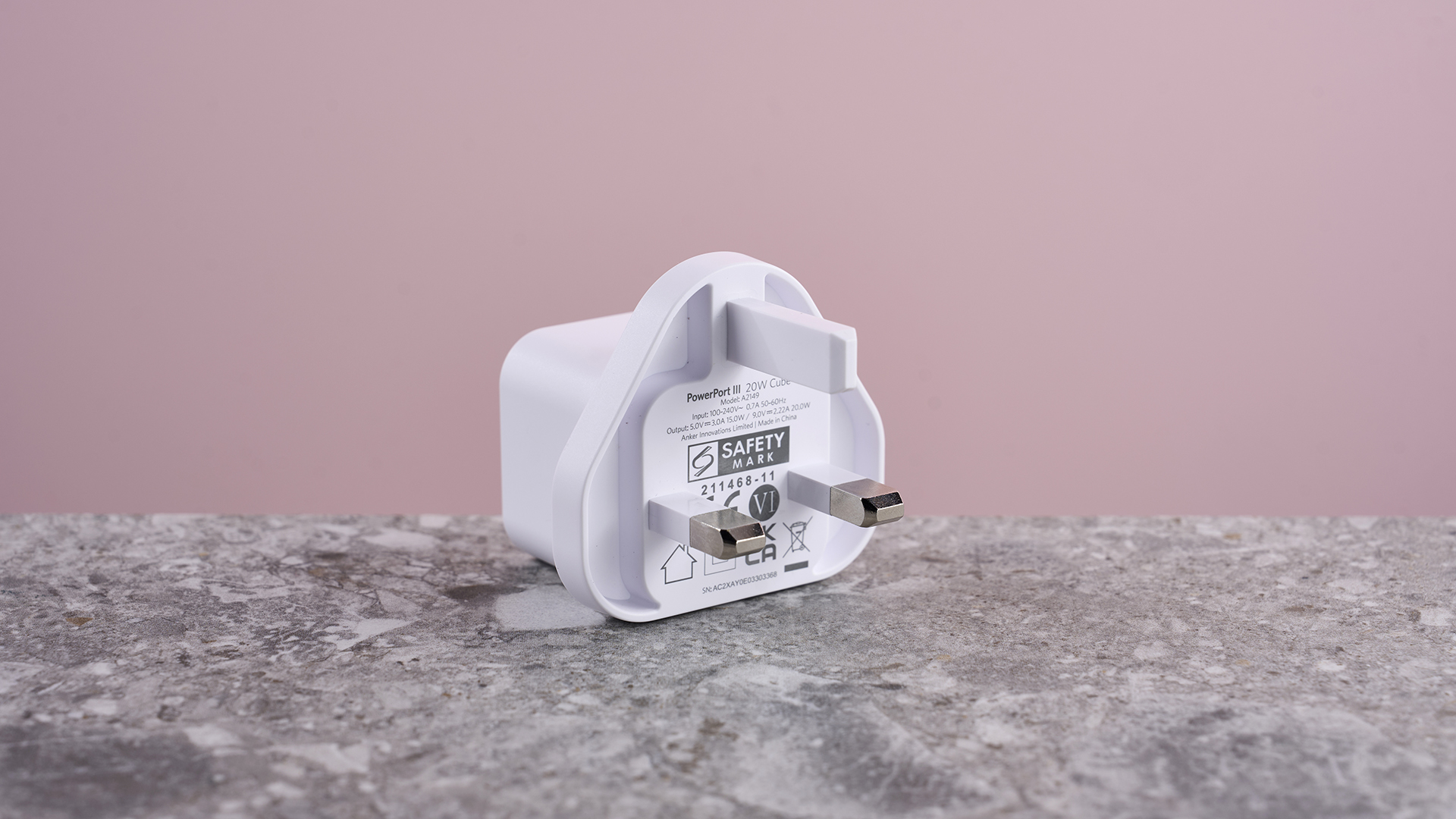TechRadar Verdict
The Anker PowerPort III 20W is a cheap, mini phone charger that won’t break the bank. This isn’t the ideal pick if you have a more modern handset that can take on more than 20W – something that significantly holds it back. On top of that, it lacks foldable prongs, reducing its marks in the portability department. Overall, this is a competent plug, but far from the best option on the market.
Pros
- +
Very cheap
- +
Tiny build
- +
Capable of fast-charging
Cons
- -
Pretty low wattage
- -
Only one charging port
- -
Prongs not foldable
Why you can trust TechRadar
Anker PowerPort III 20W review
Check out the Anker PowerPort III 20W, a tiny budget wall charger that will get your devices back to full health – but not as quickly as you might like.
As the name suggests, this plug is only capable of delivering a maximum power output of 20W. Well, I say only – for many this will be enough. For instance, my Samsung Galaxy Z Flip 4 could fast-charge with this plug and went from 0% to 100% in just over an hour and a half – not bad. However, this phone requires a 25W power output to enter into super-fast charging – something the Anker PowerPort III 20W can’t provide. More modern handsets – like the iPhone 16, for instance – can even charge above 30W, so this plug won’t cut it if you want top-tier battery life restoration speeds.
However, this charger isn’t only missing a bit of horsepower, it also falls a little flat design-wise, especially compared to some of the best Android phone chargers and best iPhone chargers.
My main complaint would be that it’s not perfect portability-wise. A lot of Anker’s cheap wall chargers have foldable prongs, which is great if you’re not carrying a bag and just want to slip the plug into your pocket. Unfortunately, the Anker PowerPort III 20W skips on foldable prongs and leaves them protruding at all times – thumbs down from me. Having said that, its tiny size is super-effective in-use, making it ideal for when you're working with a tight space.
The overall shape of this charger is a little bit strange, though, and not exactly in a good or charming way. The charging element is more of a cube shape, with the adapter appearing slightly shoehorned on the end of the plug. Combine this with the lack of foldability and you’re looking at a bit of an awkward design.
In the PowerPort III 20W’s defense, it's a very cheap charger, typically priced at just £11.99 (about $16 / AU$23). I’ve also seen it drop below the £8 ($11 / AU$15) mark on Amazon UK – so value-wise, it's still decent. This cost doesn’t include a USB-C cable though, so if you don’t have one of these already, you’ll need to purchase one separately.
Overall, this is a perfectly capable wall charger, but it’s not going to blow you away. More modern devices are capable of charging at significantly higher power-levels than 20W, so although this is a cheap option, it might not offer the longevity you’re looking for. Combine that with its sub-par design and I have no choice but to suggest you give this plug a miss. Instead, I'd recommend opting for the Anker Nano USB-C Wall Charger (30W) which offers more power, a neater aesthetic and yes, foldable prongs (more on this later).

Anker PowerPort III 20W review: Price & specs
| Price | £11.99 (about $16 / AU$23) |
| Total power output | 20W |
| Number of ports | 1 |
| Port type(s) | 1x USB-C |
| Dimensions | 1.9 × 1.8 × 1.3 inches / 49 × 45 × 33mm |

Should I buy the Anker PowerPort III 20W?
Buy it if…
You don’t want to splash the cash
At just £11.99 (about $16 / AU$23), this charger won’t set you back very far at all. On top of that, I’ve seen it go on sale at Amazon UK for less than £8 – that’s solid value, even if this charger does have some significant shortcomings.
You’re working with a tight space
It may not be the best in terms of portability, but in-use this charger’s tiny size makes it super practical. Let’s say your desk is pretty close to your wall socket. Well, thanks to its mini, cube-like body, this charger should be able to squeeze into some spaces.
Don't buy it if…
Your phone supports charging over 20W
If you want top-speed charging for your brand new handset, this plug might not be able to give you what you’re looking for. Anker offers a handful of top chargers with 30W maximum power output and more (see Also Consider), so fear not, there are plenty of great options available.
You need to charge multiple devices simultaneously
The Anker PowerPort III 20W only has one USB-C port, so if you want a plug that can handle lots of devices at once, look elsewhere. One strong option on this front is the UGreen USB-C 40W, which can fast-charge two devices simultaneously.
Anker PowerPort III 20W: Also consider
Anker Nano USB-C Wall Charger (30W)
Yep, it's Anker again. The charging experts really knocked it out of the park with the Anker Nano USB-C Wall Charger (30W) – a sleeker, speedier alternative that’s well worth checking out. It has an attractive, textured outer casing, beautiful color options and even foldable prongs – something the Powerport III 20W skips out on. There’s a catch though – this is significantly more expensive, coming in at $18.99 / £19.99 (about AU$30). The significant step-up in quality makes it worth the extra spend in my view, however.

Harry is a Reviews Staff Writer for TechRadar. He reviews everything from party speakers to wall chargers and has a particular interest in the worlds of audio and gaming. Harry has a background in business tech journalism, particularly around the telecoms industry.
